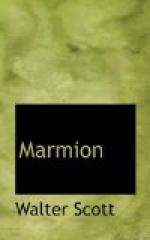’Betide, betide,
whate’er betide,
Haig shall be
Haig of Bemerside.’
line 420. Alexander iii was the last of his line, which included three famous Malcolms, viz. Malcolm ii, grandfather of the ’gracious Duncan,’ who died in 1033; Malcolm Canmore, who fell at Alnwick in 1093; and Malcolm iv, ‘The Maiden,’ who was only 34 at his death in 1165. The reference here is probably to Canmore.
Stanza xxiii. line 438. See Chambers’s ‘Encyclopaedia,’ articles on ‘Earth-houses’ and ‘Picts’ Houses.’
line 445. Legends tell of belated travellers being spell-bound in such spots.
line 461. The reference is to Edward I, who went as Prince Edward to Palestine in 1270, so that the legend at this point embodies an anachronism, Edward became king in 1274. His shield and banner were emblazoned with ‘three leopards courant of fine gold set on red.’
Stanza xxiv. line 472. Largs, on the coast of Ayrshire, opposite Bute.
line 479. The ravens on the Norse banners were said to flutter their wings before a victory, and to let them droop in prospect of a defeat.
line 487. ’For an account of the expedition to Copenhagen in 1801, see Southey’s “Life of Nelson,” chap. vii.’—Lockhart. There may possibly be a reference to the bombardment of Copenhagen in 1807.
Stanza xxv. line 497. The slight wound was due to the start mentioned in line 462. He had been warned against letting his heart fail him.
line 503. Scott quotes thus from the essay on ‘Fairy Superstitions’ in the ‘Border Minstrelsy,’ vol. ii., to show ’whence many of the particulars of the combat between Alexander iii and the Goblin Knight are derived’:—
’Gervase of Tilbury (Otia Imperial ap. Script, rer. Brunsvic, vol. i. p. 797), relates the following popular story concerning a fairy knight: “Osbert, a bold and powerful baron, visited a noble family in the vicinity of Wandlebury, in the bishopric of Ely. Among other stories related in the social circle of his friends, who, according to custom, amused each other by repeating ancient tales and traditions, he was informed, that if any knight, unattended, entered an adjacent plain by moonlight, and challenged an adversary to appear, he would be immediately encountered by a spirit in the form of a knight. Osbert resolved to make the experiment, and set out, attended by a single squire, whom he ordered to remain without the limits of the plain, which was surrounded by an ancient intrenchment. On repeating the challenge, he was instantly assailed by an adversary, whom he quickly unhorsed, and seized the reins of his steed. Daring this operation, his ghostly opponent sprung up, and darting his spear, like a javelin, at Osbert, wounded him in the thigh. Osbert returned in triumph with the horse, which he committed to the care of his servants. The horse was of a sable colour, as well as his whole accoutrements,




